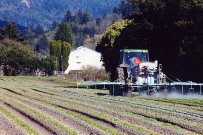Dear friends,
Given the recently released Klamath Hydroelectric Agreement, and that agreement’s “indivisibility” from the Klamath Basin Restoration Agreement (KBRA), readers might be interested in revisiting the analysis of the KBRA that I wrote for the NEC in April of this year.
Greg King
President, Siskiyou Land Conservancy
April 23, 2009
===================================
Analysis
The Klamath Basin Restoration Agreement
Overview
The Klamath Basin Restoration Agreement (KBRA) is nearly 300 pages long. It is more than three years in the making, crafted by twenty-six parties as a “settlement” agreement designed to remedy many longstanding conflicts in the Klamath River basin. The Klamath Settlement Group (KSG) includes several U.S. government agencies (Bureau of Reclamation, Fish and Wildlife Service, National Marine Fisheries Service, Department of Justice), the states of California and Oregon, four Indian tribes, two fishing organizations and eight conservation groups.
Early negotiations began with a focus on dam removal. PacifiCorp, the Salt Lake City-based energy company, operates several dams on the Klamath River as part of the Klamath Hydroelectric Project. The four lowermost of these dams — J.C. Boyle, Copco I, Copco II and Iron Gate — have long been the focus of dam removal advocates. These dams block 350 miles of upriver salmonid spawning habitat. The reservoirs behind the dams are shallow and warm, ideal conditions for growing the toxin microcystin, which has been measured in the reservoirs at levels 4,000 times higher than what the World Health Organization considers a “moderate” human health risk.
PacifiCorp attended early KSG meetings, but soon the company left negotiations, apparently taking with them any provision for dam removal. The KBRA became a “water deal” only. Negotiations with PacifiCorp stalled for nearly two years, but were taken up again in 2008 and today remain ongoing.
The NEC understands the necessity of solving longstanding conflicts over water in the Klamath basin. However, creating the KBRA out of a dam removal negotiation has stalled the dam decommissioning process and created a catchall agreement that is so confusing, unwieldy, and legally unsustainable that it could kill dam removal altogether. Yet KBRA parties are this year expected to ask Congress to approve and fund the deal.
The Northcoast Environmental Center supports many elements of the KBRA, in particular provisions for habitat restoration and funding for tribal fisheries programs and land acquisition. However, many of the restoration projects, and much of the restoration funding contained in the KBRA, could occur with or without the Agreement. The NEC has therefore withdrawn from further negotiations of the KBRA, owing to our inability to negotiate changes in several provisions of the Agreement that we consider onerous at best. Some of these provisions are outlined below.
Water for Farmers, but Not For Fish
The KBRA would provide an annual guaranteed water delivery to farmers, who receive water from the upper Klamath River via the federal Klamath Reclamation Project. Under the KBRA farmers would receive ample water even in dry years, when they would be guaranteed a minimum of 330,000 to 340,000 acre-feet during the March-October irrigation season. In wet year farmers could take up to 385,000 acre-feet of water.
In addition, a part of the $200 million in farmer subsidies contained in the KBRA budget could be used to expand groundwater pumping in the upper basin, further draining in-stream Klamath River flows.
However, the KBRA does not guarantee water deliveries for salmon. Nor does the Agreement provide a “goal” for improved runs of Klamath River fish. The science in the KBRA — which models anticipated river flows — was designed to fit the farmers’ negotiated water allocation. The risk of too little water is squarely on the fish, with irrigators getting their water first and fish getting what’s left.
Upriver farmers have little to do with the four lower Klamath dams. The dams lie dozens of miles downstream of the upper Klamath farming region, and they do not provide irrigation water or flood control. With allies in the Bush Administration, however, Klamath farmers were able to exercise political clout and dictate many of the provisions of the KBRA.
Scientific flow modeling in the KBRA was aimed at achieving optimum flow levels only for fall Chinook salmon. This may not be the best scenario for other species including spring Chinook, whose runs are quickly diminishing in the basin, and the ESA-listed Coho salmon. These species could be adversely impacted by flows that are predicted to be extremely low during adult Coho migration. KBRA flows also have not been scrutinized for other species such as sturgeon and lamprey.
Klamath farmers have never before enjoyed a guarantee of water delivery from the Klamath Reclamation Project. This was clear in 2001, when the U.S. Bureau of Reclamation reduced water deliveries to upriver Klamath farmers to 75,000 acre-feet in order to provide more water for Coho salmon, which are protected under the U.S. Endangered Species Act. The water reduction resulted in planted fields drying up and significant crop losses. It also resulted in prominent community members in the upper Klamath basin taking the law into their own hands by breaking into Klamath River pump stations and forcing open the floodgates to their fields. What the water restriction likely avoided, though, was a massive fish kill.
Over the next several months, in order to bolster the reelection chances of Oregon Republican Senator Gordon Smith, Vice-President Dick Cheney personally intervened on behalf of Klamath farmers. By coercing federal scientists to alter their findings on low Klamath flows, farmers received a full water allocation even though 2002 was another dry year. Smith received farmer support and was narrowly reelected. That year 400,000 acre-feet of water, more than half of the river’s flow, ran out of Upper Klamath Lake and directly into the “A Canal,” which serves upriver farmers (see graphs). The result was the largest adult fish kill in U.S. history: at least 68,000 Chinook salmon died that year.
Since 2006 federal courts have enforced the Endangered Species Act by mandating minimum dry season flows for salmon. The court required that flows not dip below 1,000 cubic feet per second (cfs) at Iron Gate Dam. The KBRA would reverse this guaranteed flow for fish and thus undermine protections provided by federal law — protections that have thus far prevented another fish kill.
Long-term Petrochemical Farming in the Klamath National Wildlife Refuge
The Klamath National Wildlife Refuge system is America’s premier waterfowl habitat in the lower 48 states. The importance of this vast wetland ecosystem was recognized as early as 1908, when President Teddy Roosevelt established the Klamath National Wildlife Refuge by setting aside 81,000 acres of marsh and open water in Lower Klamath Lake as the nation’s first refuge for migratory birds.
Nonetheless, since that time the U.S. Bureau of Reclamation, in creating its massive Klamath Reclamation Project, has managed to drain, dyke, dewater and fill 75 percent of the 350,000 acres of wetlands that once constituted one of the greatest wetland ecosystems in North America. Currently, commercial agriculture dominates fully one-third (22,000 acres) of the 64,000 acres in the Tule Lake and Lower Klamath Lake refuges. A provision of the KBRA would make this pesticide-intensive farming a permanent feature for the next 50 years, despite the fact that several of the organizations and tribes involved in KBRA negotiations have long opposed refuge farming.[1]
KBRA section 15.4.3 states: “The Parties support continued lease land farming on TLNWR [Tule Lake National Wildlife Refuge] and LKNWR [Lower Klamath Lake National Wildlife Refuge]. …” That is, signatories would be prevented from ever again opposing farming on the refuges, despite whatever damage agriculture causes to the wetlands, wildlife and the Klamath River. Further preventing such action is KBRA section 15.1.3, which states, “The fish and wildlife and National Wildlife Refuge purposes of the Klamath Reclamation Project shall not adversely affect the irrigation purpose of the Project.” This section places a higher priority on maintenance of farmlands than on protection of wildlife, an apparent violation of the 1964 Kuchel Act. The Kuchel Act regulates uses of the Klamath National Wildlife Refuge and is “dedicated to wildlife conservation…for the major purpose of waterfowl management.”
The NEC and other groups have long supported phasing out farming on the Klamath National Wildlife Refuge. This would remove from production less than 5 percent of the land currently farmed in the Upper Klamath Basin. However, it would add up to 100,000 acre-feet of water storage to the Klamath River system, with restored wetlands dramatically increasing the amount of habitat available to waterfowl and federally protected Klamath River suckers. The expanded wetlands would also provide the best possible filter for the greatly impaired water that now flows from surrounding farmlands back into the Klamath River.
Other NEC Objections to the KBRA:
- The water allocation to irrigators in the Klamath Reclamation Project is based on economics rather than science.
- The KBRA’s Drought Plan and Climate Change Reopener — essential provisions of the Agreement —will not be created until after the KBRA is signed. Also, Federal Advisory Committee Act rules will prevent NGOs, such as the NEC, from participating in creating these plans for up to two years after the KBRA is signed.
- There are no provisions to reduce pesticide use and other harmful farming practices on nearly 500,000 acres under cultivation in the Upper Klamath Basin.
- There is no meaningful provision to clean up Keno Reservoir, which will be the first reservoir that salmonids encounter once the lowermost four dams are removed. Keno Reservoir is 60 percent agricultural runoff. It is warm and toxic and is regularly the site of fish kills.
- The KBRA budget includes hundreds of millions of dollars in subsidies for farmers but no funding for dam removal. Some of these subsidies would increase groundwater pumping to the detriment of in-stream flows. Other subsidies would provide debt relief for farmers, would pay for inexpensive power for pumping water through the Klamath Reclamation Project, and would give farmers $92 million to develop a water plan with no state or federal oversight.
- The KBRA budget is nearly $1 billion and would have to be legislated by a Congress currently in a fiscal crisis. Yet the KBRA provides that any negotiated dam removal settlement with PacifiCorp will be “indivisible” from the KBRA. If Congress does not approve the KBRA, then dam removal dies on the vine. Congress could balk not only at the budget, but also at the KBRA’s usurpation of the federal Endangered Species Act and the Clean Water Act, as well as the provision for permanent farming on the National Wildlife Refuge. Ironically, the KBRA is not even needed for dam removal, nor is a negotiated settlement with PacifiCorp. The Federal Power Act provides a process through the Federal Energy Regulatory Commission to decommission dams. That process is now ongoing with respect to PacifiCorp’s dams, whose 50-year license expired in 2006.
[1] Early language in the principles guiding the Klamath Coalition stated: “For the purposes of restoring wetlands, providing fish and wildlife habitat, augmenting refuge water supplies, reducing irrigation season water demand, and improving water quality, the leasing program on Tule Lake and Lower Klamath National Wildlife Refuges for commercial farming shall be phased out, and the Kuchel Act is hereby amended accordingly. All existing leases for commercial farming will be honored, but once the term of the lease is ended, the lands covered by a lease shall not be released for commercial farming, and shall thereafter be managed exclusively for refuge purposes and for the purposes provided above.”

